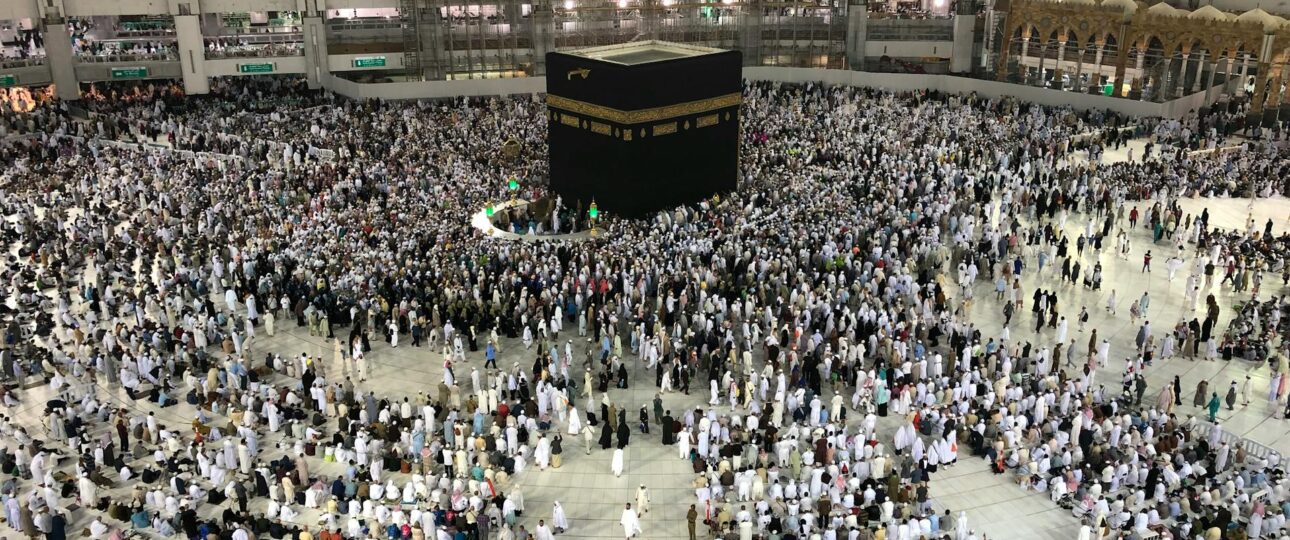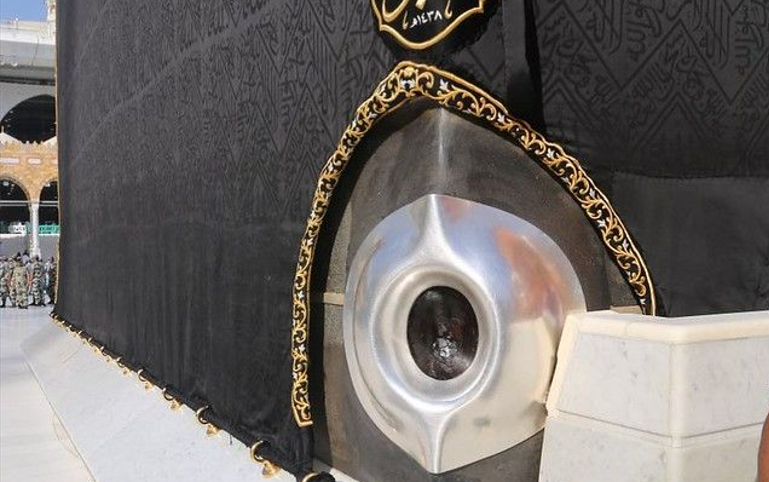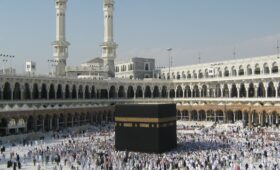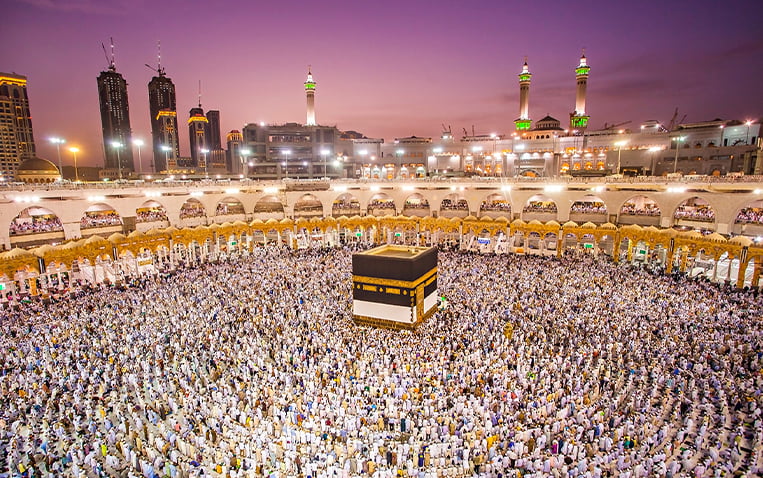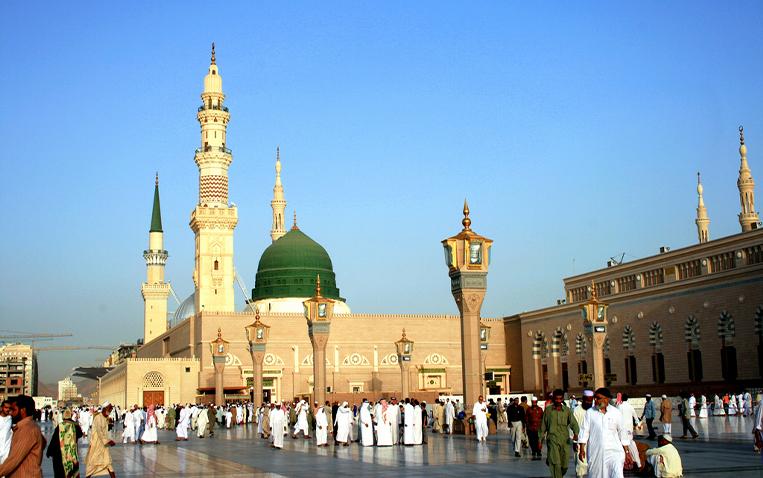Tawaf, which translates to “circumambulation” in English, involves walking counter-clockwise around the Kaaba. Tawaf is a sacred ritual that is most frequently performed during the Hajj and Umrah pilgrimages in Islam. Pilgrims walk around the Kaaba at Masjid al-Haram in Makkah, Saudi Arabia during the Umrah ritual. Tawaf is an integral component of Muslim worship, representing submission and devotion to Allah.
This spiritual pilgrimage unites believers from different backgrounds into a single community in performing this sacred ritual. Before undertaking Tawaf, pilgrims must ensure they are performing ritual purification (wudu or ghusl), dress modestly (men often wear Ihram while women should adhere to Islamic dress codes), and observe ritual purity before beginning Tawaf.
Rules of Tawaf
Ritual Purity (Taharah)
Before performing Tawaf, one must ensure they are in a state of ritual purity. Usually, this involves carrying out an ablution, or wudu, which involves washing particular body parts like the hands, face, and feet. For pilgrims engaging in certain activities that invalidate this form of cleansing ritual known as Wudu. For others who have performed certain activities that invalidate Wudu such as physical contact sports activities which invalidate Wudu (wudu), full body cleansing known as Ghusl may be necessary instead.
Dress Modestly (Hijab)
For men, dressing modestly is a fundamental principle of Islamic practice. Men typically don the ihram – an easy garment designed to cover all parts of the body – while for women this typically includes wearing clothing covering the body modestly; such as wearing hijab (headscarf) and loose-fitting clothing that hides body shapes.
Intention (Niyyah)
Before embarking on Tawaf, it’s vitally important to set an intention (niyyah) purely to worship Allah alone through this ritual. One should make their pledge from within their heart in this spirit of devotion and fulfill their act of worship solely with Allah in mind.
Respect for the Kaaba
Islam considers the Kaaba to be one of its holiest sites, so Tawaf is conducted with due reverence for this site. This refrained from any disrespectful behaviors like pushing or shoving while maintaining an attitude of humility and devotion towards it.
Direction of Circumambulation
Tawaf is performed by circumambulating the Kaaba in a counter-clockwise direction while keeping it on the left side, symbolizing unity and harmony within Muslim communities as they collectively circumambulate this holy structure.
Kissing or Touching the Black Stone
When performing Tawaf, pilgrims should attempt to kiss or touch the Black Stone (Al-Hajar Al-Aswad), set into the eastern corner of the Kaaba. If this is impossible due to crowds, pilgrims can point towards it while saying, “Allahu Akbar!” (Allah is Greatest).
Maqam Ibrahim
After finishing their Tawaf, pilgrims visit Maqam Ibrahim near the Kaaba, to offer prayers and make supplications at this spot where Prophet Ibrahim (Abraham) once stood.
Tawaf Du’a
Tawaf ends with a prayer (du’a) asking Allah for forgiveness, guidance, and blessings while showing our gratitude and devotion.
Talbiyah during tawaf
Muslims reciting Talbiyah at Makkah during Tawaf, or the ceremonial circumambulation of Kaaba, to declare their intentions during Hajj or Umrah pilgrimages. This sacred invocation and declaration of intent are heard throughout their journey of Hajj or Umrah pilgrimages. Beginning with
لَبَّيْكَ ٱللَّٰهُمَّ لَبَّيْكَ
“Here I Am, O Allah,
Pilgrims express their readiness and willingness to answer Allah’s call by responding quickly. Reciting Talbiyah is deeply symbolic, signifying pilgrims’ submission, devotion, and eagerness to fulfill their religious duties. By circumambulating the Kaaba reciting Talbiyah they demonstrate their unity and dedication to Islam while transcending worldly distractions to focus solely on connecting with the divine.
Reciting the Talbiyah during Tawaf is an act of profound spiritual significance, commemorating its start and affirming one’s commitment to Islam. The repeated nature of Tawaf combined with rhythmic chanting of Talbiyah creates an intensely reflective experience and allows pilgrims to fully immerse themselves in spiritual experience.
Through Talbiyah pilgrims express their thanks for having this opportunity as well as seek forgiveness for any past sins they may have committed and seek closer spiritual union with Allah through this holy journey.
Duas to read During Tawaf
Here is a breakdown of duas that you must recite while performing Tawaf:
At the start of Tawaf
Ali ibn Talib (RA) recited the following dua:
سْمِ اللَّهِ وَاللّٰهُ أَكْبَرُ، اللَّهُمَّ إِيْمَاناً بِكَ وَتَصْدِيْقاً بِكِتَابِكَ، وَوَفَاءً بِعَهْدِكَ، وَاتِّبَاعاً لِسُنَّةِ نَبِيِّكَ مُحَمَّدْ
In the name of Allah, Allah is the greatest. O Allah, out of faith in You, conviction in Your book, in fulfillment of Your covenant, and in emulation of Your Prophet’s Sunnah (PBUH).
At the Rukn al-Yamani
According to al-Hakim’s Mustadrak, anyone reciting this dua at Yemeni corners will hear seventy thousand angels respond Ameen in affirmation:
اللَّهُمَّ إِنِّي أَعُوذُ بِكَ مِنَ الْكُفْرِ وَالْفَاقَةِ وَمَوَاقِفِ الْخِزْيِ فِيْ الْدُنْيَا وَالآخِرَةِ
O Allah, I take refuge in You from disbelief, poverty, and from any humiliation in this world and the next.
Between the Rukn al-Yamani and the Hajar al-Aswad
The following two duas were recited by the Prophet Muhammad (PBUH):
رَبَّنَا آتِنَا فِيْ الدُنْيَا حَسَنَةً وَّفِيْ الآخِرَةِ حَسَنَةً وَّقِنَا عَذَابَ النَار
O our Lord, grant us the good of this world, the good of the Hereafter, and save us from the punishment of the fire.
اللَّهُمَّ قَنِّعْنِيْ بِمَا رَزَقْتَنِيْ وَبَارِكْ لِيْ فِيْهِ، وَاخْلُفْ عَلَ كُلِّ غَائِبَةٍ لِّيْ بِخَيْرٍ
O my Lord, make me content with what You have given me as sustenance, grant me blessings therein, and grant me that which is better than what I have lost.
The Prophet Muhammad (PBUH) recited this dua when passing the Mizab al-Rahmah, between the two corners:
اَللَّهُمَّ إِنِّي أَسْأَلُكَ الرَّاحَةَ عِنْدَ الْمَوْتِ وَالْعَفْوَ عِنْدَ الْحِسَابِ
O Allah, I ask You for comfort at the time of death and forgiveness at the time of reckoning.
How to perform Tawaf?
- Doing a Tawaf involves circling the Kaaba clockwise seven times with reverence and devotion.
- Starting by raising their hands and reciting the Takbir.
- Pilgrims may kiss or point towards the Black Stone at each circuit before praying or offering other forms of sacrifice along their journey.
Often offering prayers invoking Allah’s blessings while seeking his forgiveness or invoking blessings from Allah as part of this sacred act.
Pilgrims strive for ritual purity and focus throughout this sacred act, always keeping it on their left side; upon finishing seven circuits they may offer two Rak’ahs near Maqam Ibrahim before ending this profound spiritual experience with Zamzam water to complete this profound spiritual experience of Tawaf.
Can You Perform Tawaf Without an Ihram?
Perform Tawaf without wearing an Ihram is permitted as it is not a mandatory requirement specifically for Tawaf. Ihrams are more frequently worn during Hajj and Umrah to signify religious dedication and separation from worldly affairs, but this requirement doesn’t concern Tawaf specifically. Pilgrims should adhere to Islamic dress codes and hygiene principles when performing Tawaf, covering their bodies according to Islamic guidelines while performing the procession around Masjid al-Haram.
Ihram is not required for Tawaf, however pilgrims should still observe ritual purity (wudu or ghusl) prior to engaging in the act of performing Tawaf. Pilgrims should approach the ceremony with sincerity, reverence and devotion while remembering Allah through prayers or contemplative thoughts during Tawaf.
Ultimately the essence of Tawaf lies within one’s personal relationship with the Divine; following recommended practices such as wearing Ihram can enhance this connection while not necessitating it as such as “a must”.
Types of Tawaf
Tawaf holds an integral part in pilgrimage, acting as acts of devotion, submission and connection with Allah. Pilgrims perform these rituals with worship and humility while seeking spiritual purification and closeness to the Divine. Tawaf comes in various forms and varieties, each bearing its own particular significance and circumstance:
Tawaf al-Qudum (Tawaf of Arrival)
Upon arriving in Makkah, Tawaf al-Qudum marks the start of any pilgrimage for Hajj or Umrah pilgrims, also known as Tawaf al-Ifadah for Hajj pilgrims after having completed Arafah and Muzdalifah rituals. Tawaf al-Qudum symbolizes entering Ihram symbolizing readiness to engage in rituals associated with pilgrimage rituals.
Tawaf al-Ziyarah (Tawaf of Visitation)
Also referred to as Tawaf al-Hajj, this mandatory ritual represents one of the main parts of Hajj pilgrimage. Pilgrims perform Tawaf al-Ziyarah after performing all rituals at Mina during Hajj and symbolize their gratitude towards Kaaba as well as completion of main rites for Hajj.
Tawaf al-Wida’ (Farewell Tawaf)
Before leaving Makkah, pilgrims should perform this Tawaf to express gratitude and seek forgiveness before departing. This Tawaf is recommended as part of concluding their Hajj or Umrah pilgrimage journey.
Tawaf al-Nafl (Optional Tawaf)
Tawaf al-Nafl is performed freely outside of obligatory Tawaf rituals to gain additional blessings, honor personal vows or pray to Allah for fulfillment. Though not obligatory, Tawaf al-Nafl can be immensely spiritually rewarding and should be pursued at times of personal need or desire.
Conclusion
Tawaf is an act of devotion in Islam performed during Hajj and Umrah by pilgrims during Hajj and Umrah pilgrimage, symbolizing unity, devotion, and submission to the Divine. Pilgrims prepare themselves by entering into a state of ritual purity before dressing in modest clothing and reciting supplications before beginning Tawaf.
Tawaf rituals include kissing or pointing toward the Black Stone while reciting prayers or verses from Quranic verses while maintaining focus and worship throughout its circumambulation; upon completion pilgrims may offer prayers near Maqam Ibrahim while drinking Zamzam water to cap off this profound spiritual experience.
Tawaf is an integral and spiritually fulfilling ritual in Islam, embodying devotion, humility and communion with Allah. It symbolizes the pilgrimage journey’s essence by uniting Muslims from across the globe in worship of Allah and submission to their Creator.
Through Tawaf, pilgrims renew their faith, seek forgiveness from Allah and strive for spiritual purification – taking home experiences and blessings gained during pilgrimage back home to their lives beyond Makkah sacred precincts.
FAQ’s
Can I do less than 7 Tawaf?
No. Failing to complete 7 Tawaf circumambulations around the Kaaba during Hajj or Umrah is insufficient; seven circuits must be performed for proper completion of Tawaf.
What makes Tawaf invalid?
Tawaf can be disrupted by actions such as excessive talking, engaging in worldly activities or violating ritual purity (wudu). Furthermore, any interruptions or violations to Tawaf rules could render it invalid and render Tawaf ineffectual.
Can I drink water during Tawaf?
Drinking water during Tawaf is not strictly forbidden, though it should generally be discouraged as this can take away from its spiritual focus and reverence. Therefore, it’s preferable that Tawaf is completed without eating or drinking unless absolutely necessary.
Can I touch the Kaaba without doing Tawaf?
Yes, touching the Kaaba outside of Tawaf is permissible and allows pilgrims to approach it at any time and touch its walls and corners without necessarily performing Tawaf. However, touching it as part of Tawaf ritual requires specific intentions and procedures for its performance.

